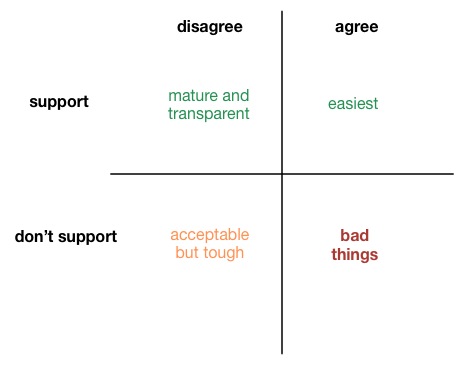Trust is the lifeblood of a team. It’s the foundation of Lencioni’s The Five Dysfunctions of a Team. Its absence, more than anything, is why teams struggle or fail.
The absence of trust puts people into a particular state — they tend to agree to decisions but not support them. To name a few examples:
- Engineers who attend architectural meetings, don’t speak up, then complain about everything afterward
- Managers who agree to a decision in front of other people then undermine it privately with their team
- Product managers who acknowledge and agree with technical constraints but push for unreasonable deadlines anyway
Defend trust. No matter how big or small the decision, strive to identify when someone is in this space — and call them on it. If you’re able to do this early and often, you can hopefully avoid other dysfunctions they will inevitably cause.
Two by Two
When it comes to negotiations, people tend to fall into one of four categories:
Agree and Support
This is the easiest thing to do — but be careful when everyone just agrees and supports everything. It’s possible to be too good at this. Huge decisions without proper discussion and friction make me a little antsy. If everyone agrees with zero resistance you could lack diversity or worse — nobody gives a crap. Most decisions worth making cause fun and sometimes challenging discussion.
Disagree and Support
This is an example of a professional who has said their peace, weighed the pros and cons and have agreed to support a decision even if they may not personally be super excited about it. People who do this understand what is best for the group — they are able to put their own reservations on hold to give things a try and trust in their teammates.
If you have team members who are able to do this, you’re lucky. Make sure to keep them included and be willing to change if what you’ve decided to try doesn’t work out. Working together with them will make the end result a lot better.
Disagree and Don’t Support
When people disagree and don’t support they are at least transparent about not being able to support something. I respect this. If someone feels that something is fundamentally wrong and will not support it, they can and should say so.
This presents some interesting problems, though: it usually means they need to switch teams or projects — and possibly companies. For their own happiness and growth it is tough to ask someone to stick around and work on something they don’t believe in.
As a leader I try to identify other projects or challenges for these folks — if you can, work out a situation where they can work on something they can support. If you can’t, then you better make sure the decision is right because you risk losing them over it.
Agree and Don’t Support
This is bad news. When someone agrees then undermines something you have a number of problems:
- They don’t feel like saying anything will make a difference: for some reason, they didn’t speak up and confront the group with why they felt it was the wrong decision. Figure out why.
- The rest of the team will hear why they are wrong on a regular basis: over time, the grapevine will fill up with underhanded comments, “I told you so”, and all sorts of papercuts that undermine what the team is doing. Aside from the morale impact, this gets in the way of iterative progress and productive failure.
- Say goodbye to personal growth: if it goes on long enough, this person will eventually be ignored or marginalized by the rest of their team. As a manager, if this happens, it’s your fault.
- It could ruin your team: the ultimate consequence is the erosion of trust within the team — for each other, for you, for the person.
Get ahead of it. When you see someone in this place, talk to them about why and ask them why they are not able to support the decision or at least talk about it with the team. That may get you on the right track. If too much time has passed, though, you will probably have to move them.
Have Backbone
Whatever challenging decisions you face, have backbone. It’s my favorite of Amazon’s leadership principles:
Have Backbone; Disagree and Commit
Leaders are obligated to respectfully challenge decisions when they disagree, even when doing so is uncomfortable or exhausting. Leaders have conviction and are tenacious. They do not compromise for the sake of social cohesion. Once a decision is determined, they commit wholly.
When you are open, honest, challenging — even when it hurts or might be inconvenient — it means you have the courage to fight for what’s right.
And when the time to talk is over, you have to prove yourself again by committing to the decision you have made as a team. When you can do this, you have the trust and respect you need to succeed together.

I think there’s another case of don’t support/don’t agree that borders passive aggressive. Especially if folks in that bubble go off and do their own widget because they don’t support/agree with the greater org.
Yeah — that tests management. Do they empower or enable that person, or do they punish them for eroding trust?
Thought, to me, if that happens it could be a sign that people aren’t making it clear what decision has actually been made — or they aren’t writing it down or doing any sort of tracking/change-management.